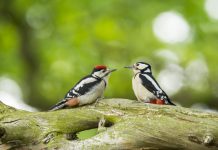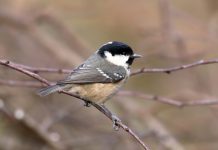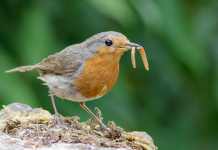Winter and early spring are particularly lean times for garden birds, and some struggle to find enough food and shelter in the wild. This is especially true of birds living in more urban areas where natural resources are scarcer.
To learn how best to help, we turned to some of our favourite bird sanctuaries and hospitals for some much needed tips on what to do this winter…
How to create a bird-friendly winter garden

Image: Holly ‘Golden King’ from Thompson and Morgan
You can do a lot to help the birds that visit your garden during the winter months simply by gardening with wildlife in mind. Over at Ealing Wildlife Group, the advice is to “avoid trimming ivy and don’t cut hedges until at least March. Both provide much needed food and shelter for overwintering wildlife.”
Leave seed heads in place over the winter too, says the team at Countryfile. Not only do they give your winter garden structure and interest, they’re also a great source of food for birds and other wildlife during the autumn and winter months.
Similarly, over at Discover Wildlife, the advice is to hang onto fallen leaves and to spread them over your flower beds: “As well as providing a rich mulch, they create a superb foraging habitat for thrushes and blackbirds in winter.”
When it comes to planting, the RSPB recommends a good mix of shrubs, saying that evergreen species are particularly useful for providing shelter for birds during the winter months. They add that, if you want to keep things native, “holly and ivy provide great cover and can be a saviour for many small birds. If your garden is suitable you could try to go for a wild look with some gorse and Juniper.”
What should you feed to birds during the winter?

Image: Suet Blocks – Insect & Mealworm (3 Pack) from Happy Beaks
“If you start feeding garden birds, make sure you start now and continue to feed them everyday,” says Gail Kennedy, mum of three and blogger at Growing Healthy Kids. She goes on to explain that the birds will come to rely on you for food, saying if you stop feeding them, they’ll have “spent a lot of unnecessary energy coming to your garden for nothing.”
That’s something with which the guys at Vale Wildlife Hospital & Rehabilitation Centre very much agree, adding that fat balls make a great winter food for garden birds. In fact, fatty foods come high on the winter menu for many of the experts we consulted. Corvid Isle, for example – a wonderful online resource for information on corvids – advises that “many wintering birds will benefit from high energy foods like suet, suet mixes and peanut butter.“
Over at Woodland Trust, the team suggests sprinkling “crumbled fat balls and seed beneath shrubs for secretive and ground feeding birds”. They go on to advocate smearing fat mixtures “into the cracks and crevices of branches or bark for treecreepers, nuthatches and woodpeckers”.
When you feed the birds is also important, says the team of experts here at Happy Beaks. It recommends getting up early to feed the birds, saying: “Mornings are an important time for birds in the winter, as they look to recover the energy they lost in the night. So try and get up early to fill any feeders.”
As well as fat, “old orchard fruits, such as apples and pears (the softer the better) are much loved by thrushes, such as Fieldfare, Redwing and Blackbird,” say the experts at British Trust for Ornithology (BTO). Rather than throwing all the leftover windfall apples onto the compost heap, chop some up to scatter on the lawn. “Feed little and often to stop food from spoiling,” they add, and only put out enough “to last a day“.
Meanwhile, don’t forget the raptors and other birds of prey like owls which can also struggle for food during particularly cold periods when prey is scarce. If you are considering leaving out food for Barn Owls, check the Barn Owl Trust website first and get it touch if you have any questions.
How to look after bird feeding stations during the winter

Image: Kingfisher Bird Bath from Happy Beaks
The most winter-ready bird feeders are those with “wide cover over feeding ports, perches and dispensing trays so seed is not buried during snow falls or storms”. This advice from Corvid Isle makes perfect sense and ensures birds can access food whatever the weather.
During the worst winter weather, feed birds twice daily in the morning and early afternoon, says the RSPB. Always try to stick to your feeding schedule so the birds know when to show up, and always “adjust the quantity given to the demand, and never allow uneaten foods to accumulate around the feeders.”
In fact, the only bird food that you should leave on the ground is the food you deliberately leave out for ground feeders like blackbirds. As Yorkshire Wildlife Trust say, these birds “rarely eat from hanging feeders, so place their food on the ground or in a feeding tray”.
Over at the Vale Wildlife Hospital & Rehabilitation Centre, the advice is to make sure you change the food in your feeders more regularly during the winter months when it’s more likely to get wet and go off. They also say you should wash your feeders regularly, a must for preventing the spread of disease. Woodland Trust recommends you should do this with hot soapy water. For additional information on how to prevent bird diseases this winter, the RSPB have published a helpful guide on keeping your bird table healthy.
Another interesting tip from Woodland Trust is to move bird tables and feeders around the garden every so often: “Not only does this reduce the build up of mess, it can also help prevent ambush predators like cats and sparrowhawks from becoming too familiar with the likely location of unwary prey.”
As well as moving your feeders, also consider moving your birdbath to a “safe sunny spot during the winter to take advantage of the warmth of the sun’s rays,” says Corvid Isle. “When temperatures are dipping just below freezing, you can prevent ice formation on your birdbath through the use of a dripper, aerator, or simply floating a small plastic ball in the pool. Dark-coloured bird baths will stay warmer than light-coloured ones.”
The team at Cuan Wildlife Rescue is also keen to remind people to be cautious of the risk of avian flu this winter. They say it’s worth wearing disposable gloves when refilling feeders and water trays, rather than washing up gloves.
How to provide winter shelter for birds

Image: Multi-Purpose Nesting Box from Happy Beaks
“Winter is a great time to put nesting boxes into trees,” says Hamish Blair from Gwent Wildlife. “Different birds will prefer different types of box and at different heights,” and many of the more sociable species will use them to huddle together for warmth through the colder months. The Senior Conservation Ecologist at Gwent Wildlife, Andy Karran, adds that you should also try to leave as much ivy in your garden as you can. He explains that “its dense foliage is great for nests and winter roosting” and the berries that arrive in March help to get birds through to spring.
Woodland Trust also recommends bird boxes for overwintering birds, adding that an orientation which avoids direct sunlight works best. Countryside says you should use wood shavings rather than sawdust for bedding during the winter because this offers birds more in the way of warmth and comfort during the coldest time of year.
What to do if you find an injured bird during the winter

Image: @cuan_wildlife_rescue
“No bird is naturally calm or friendly to humans. If you can pick up a bird it is most likely injured or in shock, which in some cases can kill a perfectly healthy bird,” says the team at Mousehole Wild Bird Hospital. If you do find a bird in distress, they advise that the best thing to do is: “Place the bird in a box large enough for it, with plenty of air holes. Offer it a drink of water in a bowl suitable for the bird’s size. NEVER MILK though. Place the box in a warm quiet area.”
The Wildlife Trusts add: “You can wrap a hot water bottle in a towel and place it inside or next to the box, making sure the bird can get away from the heat if it wants to.” If the bird begins to pant, you should remove the heat source immediately to prevent it from overheating.
Cuan Wildlife Rescue says: “Once you have the bird in its box, phone your local wildlife rescue for advice – you may need to take it in to be looked after. Injured birds often need prompt treatment to prevent infection.”
Winter is a tough time for many of our native birds, but with a little help, we can make sure we give them the best chance of surviving through to nesting season in spring. For more information about what to do if you find an injured bird, or where your closest wildlife rescue centre is, visit HelpWildlife.co.uk.
Lead image: Shutterstock




















